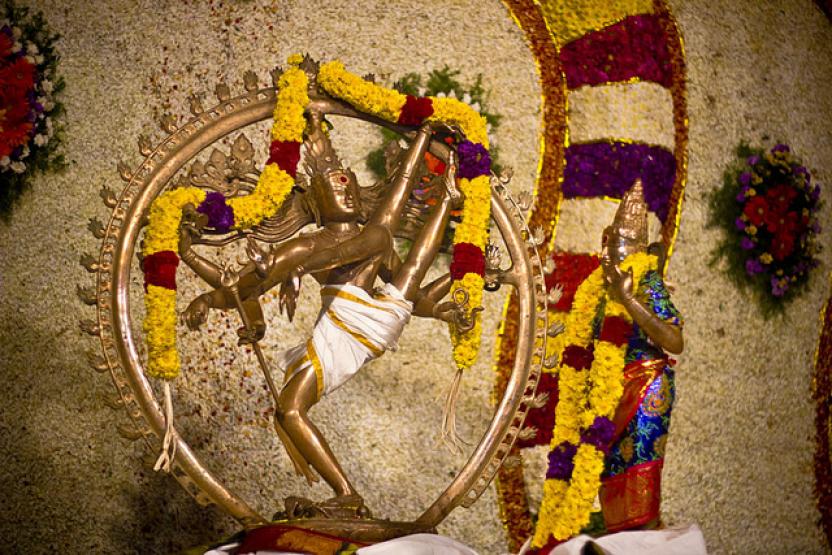Vedaranyeswarar temple is located in Vedaranyam, Tamil Nadu, India. (Vedaranyam means name of this town is kept on the Vedrayaneswarar temple of Lord Shiva). The temple has a traditional South Indian style, with features of a spectacular five-tier architecture, with delighted entrance called 'Rajagopuram'. The temple houses an emerald image of Lingam, locally called Maragatha Lingam. The central shrine faces east and holds the image of Lord Shiva in the form of Lingam made of granite. The image of the deities Lord Muruga, Lord Ganesha, Nandhi (the bull and vechicle of Lord Shiva) and Navagraha (nine plantary deities) are located in the front of sanctum.
The temple was built by Aditya Chola King along with banks of the river Kaveri. It is an important shrine of Lord Thiyagaraja. The main deity of this temple is Lord Vedaranyeswarar along with Goddess Durga, Lord Murugan and Goddess Saraswati is in blissful appearance. There is a long and large pillar in the temple which has twelve zodiac signs encrypted in the pillar. Earlier the town (Vedaranyam) was referred as Tirumaraikadu which means the origin of Vedas. Vedas are work of arts & scriptures of Hindu religion. As far as the history is concerned, it is said vedas used to worship Lord Shiva in this place & hence the name vedaranyam. Another story says, that Lord Rama who is the seventh form of Lord Vishnu came here to free himself from the sins that he had committed in his fight against the demon Ravana. You can still see the footprints of Lord Rama in the temple. After taking the blessings of Lord Shiva, the vedas had locked the temple due to which Saint Tirugnanasambandar & Appar could not get into the temple. Speciality of the temple is Saint Appar then sang text open automatically. Everyday six periodic rituals are performed in this temple as per vedic text.
Lord Vedaranyeswarar in the form of Lingam made of Granite. As in many other Lord Vedaranyeswarar temples of Tamil Nadu, the first precinct around the sanctum of Lord Vedaranyeswarar has images of Lord Dakshinamurthy (Lord Shiva as the teacher), Goddess Durga (Warrior-Goddess) & Lord Chandikeswarar. The second precinct is surrounded by Granite Walls. Lord Shiva is Swayambumurthy in this temple. The temple has separate flag posts (Dwaja Sthambam or Kodimaram can be seen mainly in the temples built in Agama style or South Indian temples. Dwaja in sanskrit means Flag and Kodi in tamil means Flag. Sthambam means Pole. In all the temples we have a pillar in front of the Garbhagudi or Moolasthanam(Karuvarai) known as Dwaja sthambam or Kodimaram. Dwaja Sthambam or kodimaram is actually a stem of big tree and wrapped with the sheets made up of brass or copper or gold or just stone) for Lord, Goddess Ambica and Lord Ganesha. The temple is second in the rank of Saptha Vidanga Sthala of Lord Shiva. The Lord Thyagaraja idol in the temple was earlier gifted to emperor Lord Mushukunda Chakravarthi. The LordVedaranyeswarar placed praised as dancing form(Hamsa Nadana).
In this temple, the inner sanctum houses the images of the Sixty three nayanars. There are also images of (Ramanatha lingas, Lord Shanmugha, Goddess Saraswati, Lord Nataraja, Lord Bhairava, Lord Chandra & Lord Surya, Lord Saneesvara and Goddess Durga). The temple is one of sixty four Sakthi Peetam known as Sundari Peetam. Lord Thiyagarajar here is known as Bhuvani Vidangar. The dance of Thiyagarajar here in this temple is known as Hamsa Nadanam. Sthala Vriksham is Vanni Maram and Punnai Maram. Teertham is Manikarnigai and Veda Teertham. Devotees from all over it come here to seek blessing from the Lord Shiva. Most important festival of this temple is Brahmostsavam which attracts hundreds of devotees from nearby places. Eastern side of the temple is known Aadhi Sethu and bathing in this sea is equivalent to hundred baths in Rameswaram.
Important Festival
Masi Magam Bhrammotsavam in the month of (May-June), When Lord Vedarayaraneswarar goes to Aadhi Sethu on the day of Magam and go on procession of sixty three celebrated Nayanars, Aadi Pooram in the month of July-August, a festival dedicated to Goddess Ambica, Vinayaka Chathurthi in the month of August-September, kanda Sashti in the month of October-November are the festivals celebrated in the temple.
Do:
-
Do pray your Ishta Devata before pilgrimage to Temple.
-
Do contact Temple Devasthanam information centre for enquiry, temple information and for Pooja details etc.
-
Do reserve your travel and accommodation at Temple well in advance.
-
Do bath and wear clean clothes before you enter the temple.
-
Do concentrate on God and Goddess inside the temple.
-
Do maintain silence and recite Om Namahsivaya or your Istamantram to yourself inside the temple.
-
Do observe ancient custom and traditions while in Temple.
-
Do respect religious sentiments at Temple.
-
Do deposit your offerings in the hundi only.
Don't s:
-
Do not come to Temple for any purpose other than worshipping of God and Goddess.
-
Do not smoke at Temple.
-
Do not consume alcoholic drinks at Temple.
-
Do not eat non-vegetarian food in the Kshetram.
-
Do not approach mediators for quick Darshanam. It may cause inconvenient to others.
-
Do not carry any weapon inside the temple.
-
Do not wear any head guards like helmets, caps, turbans and hats inside the temple premises.
-
Do not perform Sastanga Pranama inside the Sanctum Sanctorum.
-
Do not take much time while performing Sparsa Darshanam to God in Garbhagriha.
-
Do not buy spurious prasadams from street vendors.
-
Do not encourage beggars at Temple.
-
Do not spit or create nuisance in the premises of the temple.
